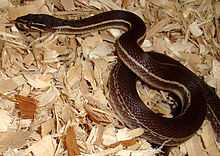Boaedon
| Boaedon | |
|---|---|
 | |
| Striped House Snake, Boaedon lineatus. | |
| Scientific classification | |
| Superkingdom: | Eukaryota |
| Kingdom: | Animalia |
| Subkingdom: | Eumetazoa |
| Phylum: | Chordata |
| Subphylum: | Vertebrata |
| Infraphylum: | Gnathostomata |
| Superclass: | Tetrapoda |
| Class: | Reptilia |
| Subclass: | Diapsida |
| Infraclass: | Lepidosauromorpha |
| Superorder: | Lepidosauria |
| Order: | Squamata |
| Suborder: | Serpentes |
| Infraorder: | Caenophidia |
| Superfamily: | Elapoidea |
| Family: | Lamprophiidae |
| Subfamily: | Boodontinae |
| Genus: | Boaedon |
| Species | |
|
7 recognized species, see article. | |
Boaedon is a genus of African Lamprophiids consisting of the "Brown" House Snakes. The genus was originally described by Duméril but the species contained were reclassified as Lamprophis by Fitzinger in 1843, this taxonomy remained the accepted until November 2010 when a phylogenetic study was published by Kelly, C.M.R et al. placing them once again in the Boaedon clade.[1] Although commonly regarded as belonging to the Colubridae, primary literature usually lists them, and related species, as belonging to the family Lamprophiidae within the superfamily which includes the venomous cobras and mambas, Elapoidea (e.g.[2])
Species
- Cape House Snake, Boaedon capensis (Duméril & Bibron, 1854)
- Brown House Snake, Boaedon fuliginosus (Boie, 1827)
- Striped House Snake, Boaedon lineatus (Duméril & Bibron, 1854)
- Dotted House Snake, Boaedon maculatus (Parker, 1932)
- Namibian House Snake, Boaedon mentalis (Günther, 1888)
- Olive House Snake, Boaedon olivaceus (Duméril, 1854)
- Hallowell's House Snake, Boaedon virgatus (Hallowell, 1854)
Undescribed Species
Archetypal Appearance
All members of the genus Boaedon are small snakes, generally attaining lengths of little more than 4 feet (120 cm) in length. Sexually dimorphic, females are always larger than males who attain lengths of approx. 2 feet (60 cm) there is some variance between species and between geographic locales of species.

Overall body colouration is typically sandy brown to black but green, orange, red and a variety of other locale specific variations do exist. All species are nocturnal by nature and present with vertically elliptic pupils, they also present with a v-shaped set of stripes stretching from the rostral scale through the eye to the rear of the head. Some specimens have very pale stripes and in others they are not present at all. Body pattern varies between species, B. olivaceus, B. mentalis & B. fuliginosus are all naturally pattern less, B. capensis & B. maculatus both have patternless variants and B. lineatus typically has lateral striping running the length of the body. These are highly variable snakes and confusion is common when attempting to distinguish them from one another.
Geographic Range
House Snakes occur in all of Sub-Saharan Africa, inhabiting dense forests and deserts as well as all other habitats in between. They are commonly found around towns where they will feast on the rodents which gather there.
Other
| Wikimedia Commons has media related to Boaedon. |
- House Snake Forums
- House Snake Captive care Guide
- Informational, Boaedon Specialised Website & Forum. Boaedon.com
Notes
- ↑ Kelly, C.M.R., et al. Molecular systematics of the African snake family Lamprophiidae, Fitzinger, 1843 (Serpentes: Elapoidea), with particular focus on the genera Lamprophis, Fitzinger 1843 and Mehelya, Csiki 1903. Mol. Phylogenet. Evol. (2010), doi:10.1016/j.ympev.2010.11.010
- ↑ Kelly, C.M.R., et al. Molecular systematics of the African snake family Lamprophiidae, Fitzinger, 1843 (Serpentes: Elapoidea), with particular focus on the genera Lamprophis, Fitzinger 1843 and Mehelya, Csiki 1903. Mol. Phylogenet. Evol. (2010), doi:10.1016/j.ympev.2010.11.010